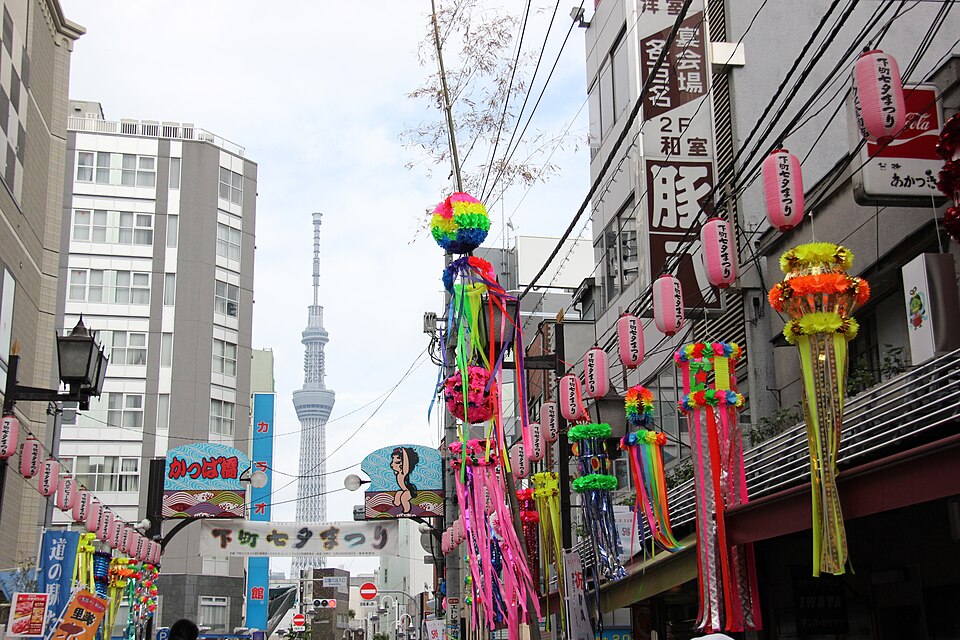Every summer in Japan, a gentle kind of magic arrives. Streets are strung with streamers, bamboo branches wave with colorful slips of paper, and families quietly pen their dreams to the stars. This is Tanabata, the Star Festival, celebrated each year on the seventh day of the seventh month.
In 2025, that means July 7 for much of the Tokyo metro area, though some regions (like Sendai) still follow the lunar calendar and celebrate in early August. Wherever and whenever it’s held, Tanabata is a beloved summer ritual: quiet, joyful, and deeply personal.
A Tale Written in the Stars
The roots of Tanabata stretch back over 1,000 years, first introduced to Japan in 755 CE through a festival called Kikkōden, itself inspired by the Chinese Qixi Festival.
At the heart of Tanabata is a romantic legend about two star-crossed lovers: Orihime (Vega), a princess who wove beautiful cloth on the banks of the Milky Way, and Hikoboshi (Altair), a cowherd tending his celestial herd across the galaxy. The two fell deeply in love, but their devotion caused them to neglect their duties, angering Orihime’s father, the Sky King. He banished them to opposite ends of the Milky Way, allowing them to reunite only once a year—on the seventh day of the seventh month.
But even that one reunion was not guaranteed. If the skies were cloudy or rain fell, the lovers could not meet. According to legend, a flock of magpies would form a bridge across the stars—but only if the weather was kind.
How It’s Celebrated Today
Today, Tanabata is celebrated with paper wishes and bamboo branches. Children (and plenty of adults) write tanzaku, or small colored strips of paper, bearing wishes for everything from test results to true love. These are hung on stalks of bamboo in homes, shopping arcades, train stations, and schools acting as mini forests of hope left to sway in the summer breeze.
Festivals often accompany the season, with food stalls, fireworks, and glowing decorations. Though Tanabata is quieter than many other Japanese holidays, it’s one of the most heartfelt.
Where to Celebrate in 2025 around Kanto
Hiratsuka Tanabata Festival – July 4–6
Kanagawa’s largest Tanabata celebration features giant streamers, parades, food booths, and crowds in yukata. It’s one of the three most famous Tanabata festivals in Japan and well worth the trip from Tokyo.
http://www.tanabata-hiratsuka.com/
Asagaya Tanabata Matsuri – August 7-11
A local favorite, Asagaya’s festival transforms the shopping arcade with giant handmade papier-mâché characters—everything from anime stars to sea creatures dangle from the rafters.
https://experience-suginami.tokyo/2015/09/asagaya-tanabata-festival/
Shitamachi Tanabata Matsuri – July 4–8
Held near Kappabashi and Asakusa, this quieter celebration offers old-school charm, local flair, and a break from the tourist crowds. Shops compete with colorful decorations strung high above the streets.
https://www.city.taito.lg.jp/event/kanko/shitamathitanabata.html
Tips for First-Timers
- Write a wish: Most public displays offer paper and pens—no need to bring your own.
- Watch the weather: Tanabata is all about stargazing and clear skies. Some festivals will postpone in case of rain.
- Don’t stress the date: Some events shift to early August to match the lunar calendar—check local listings.
- Bring cash: Festival stalls often don’t accept cards.
- Keep it green: Bamboo and tanzaku are often composted or ritually burned afterward. Dispose respectfully.
Tanabata isn’t about loud music or massive crowds—it’s about hope. It’s about pausing, even just for a moment, to dream. Whether your wish is for love, health, travel, or simply a better tomorrow, there’s something powerful in tying it to a branch and letting the breeze carry it skyward.
This July, take a moment. Look up. And make a wish.
Laika ac from USA, CC BY-SA 2.0, via Wikimedia Commons

